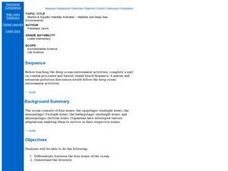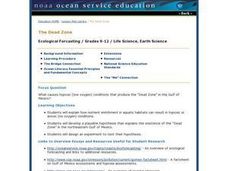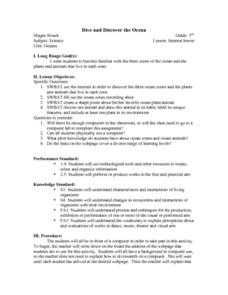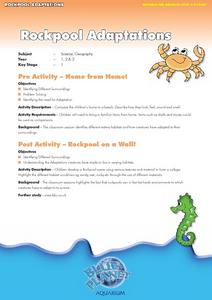Curated OER
Habitats and Deep Sea Environments
Students examine and identify the characteristics of the four zones of the ocean. They discover the amount of diversity in marine habitats. They also explore the adaptations organisms have that have allowed them to survive.
Curated OER
Critters in the Classroom
Students investigate with sea urchins. In this ocean habitat lesson, students observe sea urchins and other ocean grazers. Students work with lab equipment to examine the anatomy of these creatures.
Curated OER
The Dead Zone in the Gulf of Mexico
Students explore hypoxic (low oxygen) conditions in the Gulf of Mexico. In this ocean habitat lesson, students hypothesis, design and implement an experiment to explain the existence of the "Dead Zone" in the Gulf of Mexico.
Curated OER
Habitats
In this habitats learning exercise, students view and discuss four slides with four different habitats found in the rain forest, desert, ocean/coral reef and in the Savannah/grasslands. Students color each slide with vibrant colors.
Curated OER
Art/Ocean Scene
Students draw and color an ocean scene based on the paintings of Wyland. In this ocean art lesson plan, students view slides of seascapes before they complete their project using oil pastels.
Curated OER
Comparing Habitats: Ocean and Rainforest
In this habitat worksheet, students will draw a Venn diagram and compare a rainforest habitat with a coral reef habitat. Students will follow step by step directions to complete the activity.
NOAA
What's New?
Biodiversity in some areas is more diverse than one might think. Using a two-day lesson plan, pupils consider the biodiversity of the Hudson Canyon and the characteristics of one organism. They begin with an analysis of the common...
Curated OER
Where Do They Live?
In this animal habitat worksheet, young scholars color a picture of 3 habitats. They then cut and color 12 animal pictures. Students paste the animals in the spaces, according to where they live.
Curated OER
Ocean Exploration
Students explore a simulated ocean floor. In this environmental lesson plan, students take on roles of an ocean dive team exploring the ocean floor. Dive logs will be created and the students will explore their sections of simulated...
Curated OER
Sand Shakes & Mud Pies: Investigating Sediment
Take a field trip to a location where water and land meet to study patterns of sediment organization in wet habitats: river or ocean beaches, sand dunes, tidal marshes, the edge of a pond, or a woodland stream. Small groups collect pairs...
Curated OER
Tracking Narwhals in Greenland The Ocean Unicorn
Students study the ecology, habitats, geographic range and feeding habits of narwhals. They determine at least three reasons for the decline in the narwhal populations and complete the accompanying worksheets.
Curated OER
So, What's it Doing Today?
Students describe short-term variations in oceanographic parameters in the Gulf Stream. In this ocean habitats lesson students use satellite imagery to obtain information in the Gulf Stream.
Curated OER
Dive and Discover the Ocean
Third graders investigate the three zones of the ocean and the plants and animals that live in each zone. Projects produced are shared with classmates in a share circle where the unique features of the animal and zone selected are...
Curated OER
The Magic School Bus Goes to Mussel Beach
Students investigate tides and create a model of an intertidal zone. In this hands-on marine science lesson plan based on a Magic School Bus book, the teacher leads students in a discussion about tides, then helps students model a tide...
Curated OER
Marine & Aquatic Habitats Activities - Creatures in the Coral
Students describe unique adaptations of organisms that live in the coral reef habitat, read various books pertaining to coral reefs and ocean life, and construct a wheel demonstrating the relationships between certain coral reef...
Curated OER
Rockpool Adaptations
In this rockpool adaptations worksheet, young scholars study a rockpool habitat and compare it to their own habitat. Students use their senses to describe a rockpool habitat. They bring in items from home and items from a beach to make...
National Geographic
Eat an Alien Invader
If you are looking for a lesson about invasive species to ocean habitats, you have arrived! Introduce the concept to learners and have them read an article about marine invasive species. Vocabulary, relevant web links, and a cute handout...
Curated OER
Life on the Edge: Exploring Deep Ocean Habitats Cool Corals
Students research the basic morphology of Lophelia corals and polyps to determine the significance of these organisms. They detail the reasons that biological communities are focusing on the Lophelia corals as major conservation efforts.
Curated OER
Build a Polyp
Young scholars research coral polyps. In this coral polyps lesson, students discover the anatomy of a coral polyp and how they feed. Young scholars create an edible coral polyp model.
Curated OER
Who's New in the Deep Sea?
Students examine the methods and technology that scientists use to study the deep sea and other remote environments. In this ocean habitats lesson students make observations about organisms from video clips, generate questions and use...
NOAA
A Matter of Density
Larvae transportation on the New England seamounts is based on the density of the water. Scholars calculate density and graph salinity versus temperature to better understand the distribution of organisms in a water column. Discussions...
NOAA
It's a Roughy Life
Scientists recently discovered several previously unknown species at the Bear Seamount off the coast of New England. Scholars research these new species — benthopelagic, benthic, and seamount fish — and find out what makes them unique....
NOAA
What's the Difference?
Due to the isolation of seamounts, their biodiversity offers a great deal of information on the development of biological and physical processes. Pupils use simple cluster analysis to rate the similarity and differences in biological...
Wilderness Classroom
Ocean Life
Our oceans are composed of many complex relationships. Young oceanographers explore relationships between organisms, understand the world ocean's currents, and discover the effects of water pollution and how it behaves. There are three...
Other popular searches
- Deep Ocean Habitats
- Deep Ocean Habitats
- Ocean Habitats Year 2
- Science Ocean Habitats
- Ocean Habitats Math
- Ocean Habitats Producers
- Ocean Habitats Inquiry Based
- Ocean Habitats Inquiry
- Ocean Habitats Language Arts
- Powerpoint Ocean Habitats

























